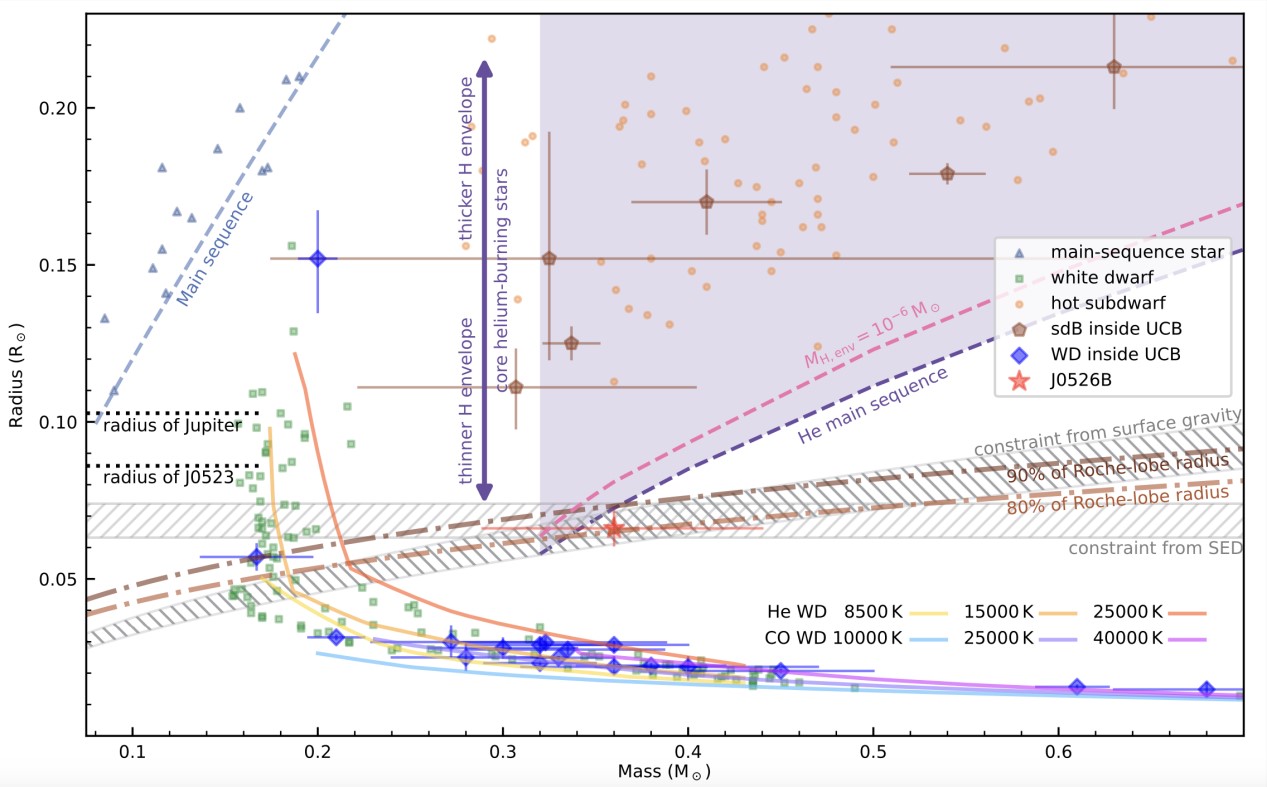Professor Xiaofeng Wang's team at Tsinghua University and his collaborators have made a record-breaking discovery using the Tsinghua University-Ma Huateng Telescope for Survey (TMTS) — a compact binary star system with the ultra-short orbital period of only 20.5 minutes (known as TMTS J0526), located about 2760 light-years from Earth, and they uncovered its physical origin. This system comprises a carbon-oxygen white dwarf star, with a mass of about 0.74 solar mass, coupled with a hot subdwarf star with a mass of about 0.33 solar mass. This hot subdwarf only has a radius seven times that of the Earth, representing the star with the minimum volume ever known. This remarkable binary is poised to become an important source of milli-Hertz gravitational waves, detectable by upcoming space observatories, such as LISA, TianQin, and Taiji. The finding of binary system also validates the theory about the formation of low-mass hot subdwarf star from the second common-envelope ejection channel.
Based on detailed Binary Population Synthesis (BPS) studies on the formation channels of hot subdwarf stars, Prof. Zhanwen Han from Yunnan Observatories and his collaborators made a prediction that a small subset of these stars formed via the second common-envelope ejection channel should have masses as low as 0.32-0.36 solar mass. The mass distribution of these stars, which are formed by the ignition of a non-degenerate helium core, contrast sharply with well-known hot subdwarf stars (with about 0.45 solar mass) that arise from helium-flash ignition in a degenerate core. Theoretical models suggest that such systems, hot subdwarf + white dwarf, could evolve into extremely tight binaries with ultra-short orbital periods (as short as 20 minutes) due to gravitational wave radiation. Prior to this finding, there had been no observational evidence for such detached binary systems with these predicted properties.

Figure 1. The TMTS J0526 binary star system depicted by an artist (Jingchuan Yu, Beijing Planetarium). Left larger star represents the hot subdwarf star, and the right smaller one represents the white dwarf star.
The TMTS is a uniquely designed multi-telescope optical survey instrument, established by Professor Xiaofeng Wang's team with the support from Ma Huateng Foundation and Tsinghua University (see https://www.phys.tsinghua.edu.cn/info/1129/4853.htm for details). Since its operation in 2020, the TMTS has been scanning the northern celestial hemisphere with a cadence of about one minute. By the end of 2023, TMTS has accumulated photometric data for over 27 million stars, which includes dozens of valuable short-period variable sources. Among these, TMTS J0526 stands out as one of the sources with the shortest period. Following the discovery, the team conducted time-resolution spectroscopic observations on this source using the 10~m Keck I telescope in Hawaii and the 10.4~m Gran Telescopio Canarias (GTC) located in La Palma, Spain. Additionally, time-series photometric observations were carried out with the 2.4 m telescope in Lijiang. Through the integration of high-frequency sampling observations of light curves and spectroscopic radial velocity variations, the research team deduced that TMTS J0526 is an ellipsoidal variable binary star with an orbital period of only 20.5 minutes. In this system, the larger and brighter component (the visible star) undergoes deformation due to the tidal gravitational forces exerted by the other more compact and fainter companion (the invisible star) (see Figure 1). The analysis of luminosity, surface gravity, effective temperature, and the mass-radius relationship indicates that the visible star is a low-mass, thin H-rich envelope hot subdwarf star (as shown in Figure 2). The characteristics of the binary system, including the low-mass hot subdwarf star, its white dwarf companion, and the extraordinarily short orbital period, are in line with theoretical predictions for the formation of low-mass hot subdwarf stars through the second common-envelope ejection channel!

Figure 2: Mass-radius relationship for different types of stars. Main sequence stars, white dwarfs, and hot subdwarfs are distributed in three distinguishable regions on this graph. The purple region represents the possible distribution area for hot subdwarf stars, and the visible companion star of the TMTS J0526 binary system falls exactly at the bottom of this region. The visible companion star J0526B is even smaller than the previously discovered compact star (2MASS-J0523), making it the smallest non-degenerate star discovered to date.
The research entitled "A seven-Earth-radius helium-burning star inside a 20.5-min detached binary" was published online in Nature Astronomy (on Feb. 9, 2024). This is the TMTS project's second article published in Nature Astronomy following the discovery of an 18.9-minute blue large-amplitude pulsator (see /info/1175/98550.htm). Dr. Lin Jie, a former postdoctoral researcher at Tsinghua University (now an associate researcher at the University of Science and Technology of China), is the first author of this paper. Associate Researcher Chengyuan Wu from Yunnan Observatories of the Chinese Academy of Sciences (a former postdoctoral researcher at Tsinghua University) and PhD candidate Heran Xiong from Australian National University are co-first authors. Professor Xiaofeng Wang is the corresponding author for this paper. The main collaborators of this paper also include Dr. Peter Nemeth from Astronomical Institute of Czech Academy of Sciences, Prof. Zhanwen Han’s and Prof. Xuefei Chen’s teams from the Yunnan Observatories, Dr. Nancy Elias-Rosa from INAF-Osservatorio Astronomico di Padova in Italy, and Professor Alexei V. Filippenko’s team from the University of California at Berkeley. This project received funding from various sources, including the National Natural Science Foundation of China, Ma Huateng Foundation, China Manned-Spaced Project, the Scholar Program of Beijing Academy of Science and Technology, and the New Cornerstone Science Foundation through the XPLORER PRIZE.
link: https://www.nature.com/articles/s41550-023-02188-2
Editor:Li Han

